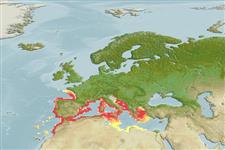>
Gadiformes (Cods) >
Gaidropsaridae (Rocklings)
Etymology: Gaidropsarus: Greek, ga, ge = the earth + Greek, ydro = water + Greek psaros = speckled, starling (Ref. 45335).
Issue
Junior synonym of Gaidropsarus macrophthalmus according to Ref. Barros-Garcia et al., 2022 (Ref. 131625:131).
Environment: milieu / climate zone / depth range / distribution range
ນິເວດວິທະຍາ
ສັດທະເລ ກ່ຽວກັບ (ຢູ່)ເທິງຊັ້ນພື້ນດິນໃນທະເລເປີດ; ບໍ່ມີການເຄື່ອນຍ້າຍ; ລະດັບຄວາມເລິກ 80 - 600 m. Temperate; 48°N - 30°N, 18°W - 30°E
Eastern Central Atlantic: western Mediterranean and northern part of central Mediterranean. Also from Spain and Portugal to Morocco and Madeira.
ຂະໜາດ / ນ້ຳໜັກ / Age
Maturity: Lm ? range ? - ? cm
Max length : 40.0 cm TL ຕົວຜູ້/ບໍ່ມີເພດ; (Ref. 1371); common length : 12.0 cm TL ຕົວຜູ້/ບໍ່ມີເພດ; (Ref. 1371)
ຄີ (ໜາມ)ແຂງຢູ່ຫຼັງປາ (ທັງໝົດ) : 0; ຄີ(ໜາມ) ແຂງຢູ່ຄີກົ້ນປາ
ກຸ່ມປາກະດູກແຂງ
ຄວາມຖີ່ຂອງກຸ່ມຖ່າຍທອດພັນ
ປາທີ່ມີການເຄື່ອນຍ້າຍຈາກທະເລໄປຫານ້ຳຈືດ ແລະນ້ຳຈືດຫາທະເລ
ປາທີ່ມີການເຄື່ອນຍ້າຍຈາກທະເລແລະໄປໄຂ່ຢູ່ນ້ຳຈືດ
ຄີກົ້ນຂອງປາ
ສັດທີ່ມີກະດູກສັນຫັຼງ
ການຖ່າຍທອດທາງກຳມະພັນຈາກພໍ່ແມ່ຫາລູກ: 0. First dorsal spine followed by a few small fleshy filaments. Two fang-like teeth at the symphysis of the upper jaw.
Found in offshore waters on mud, shell and coral bottoms. Feed on crustaceans. Spawning occurs in February. Occasionally sold in markets.
Life cycle and mating behavior
ການຈະເລີນເຕັມໄວ | ການສືບພັນ | ການວາງໄຂ່ | ໄຂ່ | ຄວາມດົກຂອງໄຂ່ປາ | ຕົວອ່ອນ
Svetovidov, A.N., 1986. Review of the three-bearded rocklings of the genus Gaidropsaurus Rafinesque, 1810 (Gadidae) with description of a new species. J. Ichthyol. 26(1)114-135. (Ref. 9985)
IUCN Red List Status (Ref. 130435: Version 2024-2)
Threat to humans
Harmless
Human uses
ການປະມົງ: ທີ່ເປັນການຄ້າໜ້ອຍ
ເຄື່ອງມື
Special reports
Download XML
ແຫຼ່ງອີນເຕີເນັດ
Estimates based on models
Preferred temperature (Ref.
123201): 12.9 - 15, mean 13.9 °C (based on 79 cells).
Phylogenetic diversity index (Ref.
82804): PD
50 = 0.5001 [Uniqueness, from 0.5 = low to 2.0 = high].
Bayesian length-weight: a=0.00490 (0.00258 - 0.00930), b=3.05 (2.88 - 3.22), in cm total length, based on LWR estimates for this species & (Sub)family-body (Ref.
93245).
ຊັ້ນເຂດຮ້ອນ (Ref.
69278): 3.6 ±0.3 se; based on diet studies.
ຄວາມຢືດຢຸ່ນ (Ref.
120179): ຂະໜາດກາງ, ປະຊາກອນຕຳ່ສຸດທີ່ໃຊ້ເວລາສອງເທົ່າ 1.4 - 4.4 ປີ (Preliminary K or Fecundity.).
Fishing Vulnerability (Ref.
59153): Low to moderate vulnerability (30 of 100).
Nutrients (Ref.
124155): Calcium = 30.4 [13.2, 62.0] mg/100g; Iron = 0.272 [0.138, 0.580] mg/100g; Protein = 16.7 [14.9, 18.5] %; Omega3 = 0.421 [0.207, 0.786] g/100g; Selenium = 22 [10, 51] μg/100g; VitaminA = 18.2 [4.1, 80.3] μg/100g; Zinc = 0.576 [0.384, 0.923] mg/100g (wet weight);
